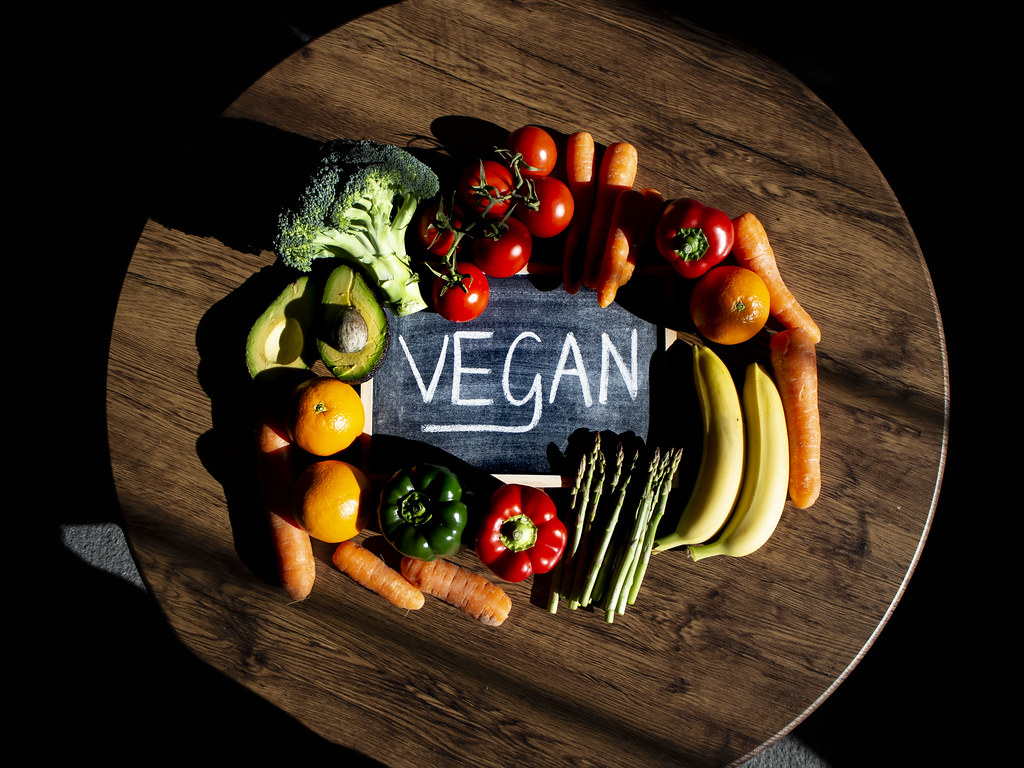Every country has its own unique cuisine likewise India is a vibrant land with a wealth of spices, sweets, and flavors that have enticed our palates for decades. From street stalls to five-star restaurants, here, foodies will find a symphony of flavors and mouthwatering delicacies that will tempt their palates. In India, the spiciest can be found in the south, where rice is a staple, while flatbread is common in the north. From steamed and slow-cooked to curried and roasted, there’s always an Indian food that suits your palate.
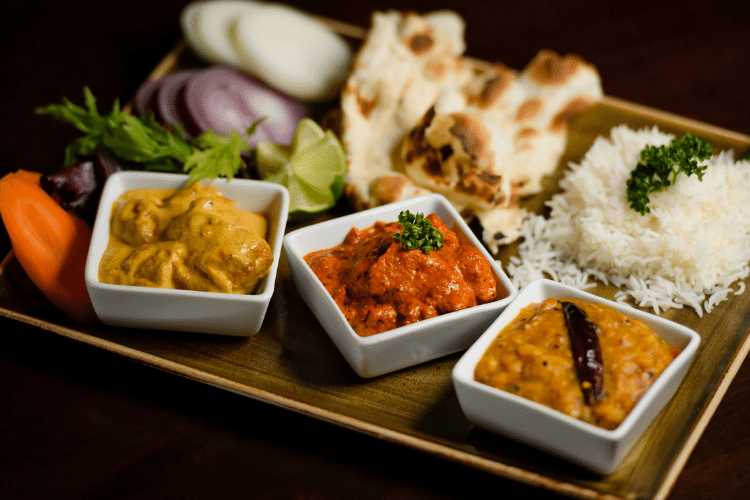
Picture yourself and your loved ones dining at an Indian restaurant. The steaming fog traveling from the kitchen, the aroma of masalas, the clattering sounds of pans, the bustling waiters running towards the kitchen, and a menu brimming with delectable starters, main courses, desserts, and drinks. Appetising? Mouth-watering? But wait, what are you going to order? Which Indian foods are the finest to try? … Of course, with so many unfamiliar dishes on the menu, choosing what to eat will be a daunting task for anyone who is traveling to India. Don’t worry. We’ve got you covered. Here is a list of 30 well-known Indian dishes that you should definitely put on your travel itinerary. Take your wallet and let’s delve into the sensory trip of Indian cuisine.
- Biryani
- Butter Chicken
- Masala Dosa with Sambar
- Gulab Jamun
- Parotta with Chicken Korma
- Chole Bhature
- Naan with Tikka Masala
- Malabar Fish Curry
- Idli
- Masala Chai
- Chana Masala
- Tandoori Chicken
- Gobi Manchurian
- Pani Puri
- Samosa
- Appam and Stew
- Pav Bhaji
- Ras Malai
- Chettinad Chicken Curry
- Matar Paneer
- Vada pav
- Puttu Kadala Curry
- Bisi Bele Bhath
- Kachori
- Roghan Josh
- Kadai Chicken
- Malai Kofta
- Karimeen Pollichathu
- Dal Makhani
- Lassi
1. Biryani:

The most opulent and beloved rice food among all Indians is biryani, which dates back to the Mughal period in the 1600s. A flavorful mixture of spices, including cinnamon, cloves, cardamom, and white pepper, along with ingredients like curd, onion, and tomato, are combined with meat (mutton, chicken, beef, prawn, and fish) and basmati rice (long grain in the north; short, dense samba in the south). Optional ingredients include nuts and black or gold raisins. To amp up the flavor and aroma, they are either slow-cooked with parboiled rice and meat marinated in seasonings or with layered raw meat and uncooked rice.
However, the tastiest biryani comes from the “Dum cooking” method, where the spices and other ingredients are almost cooked over low heat, then the round clay pot’s top is covered with a cloth, sealed with a lid, and then placed with fired charcoals to the top to allow the food to dum. To experience this lavish delicacy, you don’t need to travel to a particular location because 26 different types of biryani, each with its own distinctive regional taste, can be found throughout India, ranging from Hyderabadi and Lucknowi to Dindigul and dum biryani. Topped with fried onions and coriander for visually pleasing, this dish is best enjoyed at lunch to get the full flavor punch.
“Any Muslim wedding will not be complete without this traditional mutton biryani with chicken 65, chilled onion raita, sugary tomato jam, and kheer (rice or wheat payasam).”
Chicken 65– made with chicken that has been marinated in particular spices, coated in an egg-corn flour batter, fried, and served. Never pass up the chance to get your hands on this popular Indian food for experiencing its sumptuous flavor.
Alternative: If you’re a vegetarian, go for the vegetarian biryani and replace the chicken (65) with paneer or gobi 65 (cauliflower).
2. Butter Chicken:

At times, accidental inventions create worldwide success; similarly, here we have flavorful tomato-based butter chicken on our list. Chefs at Delhi’s Moti Mahal Restaurant came across this gourmet dish by mistake when they merged leftover tender chicken pieces with a glossy tomato-butter sauce. Tandoors, which are cylindrical ovens made of clay or metal, are traditionally used to cook chicken delicate pieces that have been marinated overnight in yogurt and spices. Once the chicken has marinated, it is grilled or roasted and simmered in a delicious sauce that has hints of tomatoes, onions, fresh cream, garam masala, and a special blend of aromatic Indian spices, including red chili powder from Kashmir.
Slow simmering allows the spices to infuse fully, producing an elite, velvety, creamy texture with a subtle spice-sweet balance. Also referred to as “Murgh Makhani” (Murgh being chicken and Makhan being butter) in Hindi, this dish has turned quite popular in a short time and sometimes comes with nuts and raisins. With each heavenly bite, this dish will shift into a splendid experience that delights your palate. Nothing compares to these when served with hot rice, crispy garlic-butter naan, or roti, and ideal for dinner or any Indian celebration. The slight sweetness will remain throughout, regardless of how spicy you want them to be—from mild to extremely fiery.
Alternative: For vegans, go for “vegan butter chicken,” which follows the same process and is made with tofu, coconut milk, and vegan butter instead. Tofu is a rich source of plant-based protein foods and gives the dish a somewhat crunchy, buttery texture.
3. Masala Dosa with Sambar:
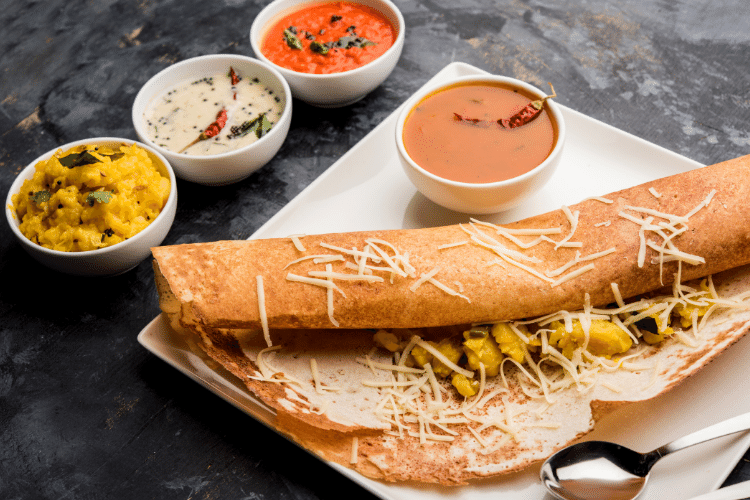
Indian dosas such as uthappam, adai, paper dosa, set dosa, 70 mm dosa, and pesarattu are iconic. However, masala dosa has become one of the most popular Indian cuisines and a globally recognized dish because of its extremely crispy outside and tendery inside with tempting fillings. Due to the fact that alcohol was deemed sinful in their religion, the dosa was accidentally made when one of the Brahmin cooks attempted to make his own liquor by fermenting rice. Unlike pancakes made with flour, this classic crisp and crepe South Indian pancake is prepared with a batter of rice and black gram (urad). They are ground into a thick batter after being soaked in water for an entire night to allow for fermentation. Fenugreek seeds provide the food a unique golden brown color and texture. This batter is poured onto a hot, greased tawa (griddle pan) and stretched out like a pancake made of French crepes.
A standard masala dosa has a filling made of mustard seeds, onions, and spicy potatoes. At last, tender coconut chutney and flavorful hot sambar (vegetable stew) are served with dosa, giving it a spicy kick. On the other hand, this food is free of gluten, and the fermentation process produces gut-friendly bacteria that aid in digestion. But whatever you load it with, this delicious dosa dish will thrill your taste buds and fill your rumbling tummy. They make the ideal breakfast and can also be eaten for dinner or as a light meal. In any restaurant, you can ask for extra chutneys and order them mildly to spicy, as per your desire.
Sambar- it is a vegetable stew with an appealing aroma that is made with Toor dal (Thuvaram paruppu or pigeon pea), cooked vegetables, tamarind water, asafoetida (Perungayam), sambar powder, small onions, tomatoes, coriander, and spices. Dosa, idli (rice cakes), or steamed rice go best with it. Coconut Chuntney – grated coconut, roasted Bengal gram, and ginger are blended to make this creamy sauce. Both sambar and chutney are finally tempered with oil (or ghee), red chilies, mustard seeds, and curry leaves.
Alternative: Although dosa is a healthy, light meal, you can replace it with adai, a more nutrient-dense dish made of mixed millets and lentils.
4. Gulab Jamun:
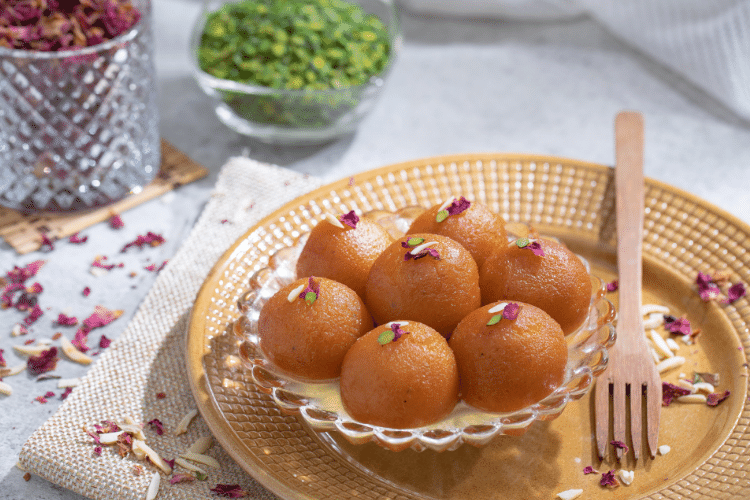
Do you know that India, a nation well-known for its heavily spiced cuisines and hearty curries, also excels at sweets? Yes. Indeed, no holiday, party, or hotel in India would be complete without the popular delicacy known as gulab jamun, which is infused with fragrance. Despite its Persian origins, they underwent changes upon their arrival. The Persian name “Gulab” means “rose water,” and the Hindi word “Jamun” means “black plum,” because it has an identical shape and size to those specific fruits. Gulab jamun is made with khoa (sugar-free thickened milk) or milk solids (curd), mixed with flour to make a dough. Side by side, the flavorful syrup is prepared by boiling sugar, rosewater, cardamom, and saffron. After being deep-fried in ghee or oil and allowed to cool, the dough balls are then soaked in a rich syrup flavored with rosewater.
Finally, to intensify the flavor, they are topped with dried nuts like cashews, almonds, and pistachios, and then sugar-drizzling balls are served. The texture turns out to be an ideal blend of rich, squishy, silky, and fluffy, with a slight stickiness enhanced by the scent of cardamom and rosewater. The most yum-yum way to enjoy gulab jamun is with vanilla ice cream; nevertheless, first-time tasters and outsiders may find it overly sweet. Try this authentic Diwali dessert to wrap up your meal and sate your sweet desire. Trust me! Every bite will tempt you to crave more sticky, sugary jamuns!
5. Parotta with Chicken Korma:

Known for its versatility, parottas are unleavened, golden-brown, and flaky flatbreads made with premium refined wheat flour (maida), mixed with ghee or oil, milk, sugar, and salt to form a dough. The dough is formed into a tiny ball, stretched into a long rope, and then coiled after resting for a while. The curled dough is flattened into a round shape and cooked on a heated ghee tawa. Parottas are layered versions of flatbreads that are also filled with eggs, meats, or paneer mixed with spices, whereas naan and chapathi are softer versions. Together with its accompaniments, such as vegetable salna, and meat curries, this extremely satisfying Indian food has become more famous worldwide. However, the pinnacle of enjoyment is having parotta with chicken korma—an ultimate dish in the South India. The taste is just irresistible! For the maximum effect, have this adored dish at breakfast.
Chicken korma- often referred to as qorma, is a popular Indian gravy that originated in 16th-century Mughlai cookery and was frequently prepared at the royal kitchen of Emperor Shahjahan. In Urdu, “Korma” means “braise,” a cooking method that includes slowly cooking the chicken. The chicken is cooked in a thick curry made with yogurt or coconut milk, coriander, ginger-garlic paste, and condiments of spices like turmeric, cumin seeds, chilies, and white or black pepper. A little sweetness and a subtle spice flavor fill this creamy, luscious, and delicate chicken gravy. You will undoubtedly be left hankering after trying this captivating gravy, and apart from parottas, you can pair it with naan and chapati.
Alternative: The option is yours; there are meat variations of this korma, such as mutton and beef, and vegetarian versions as well. For a healthy option, try the wheat parottas.
6. Chole Bhature:
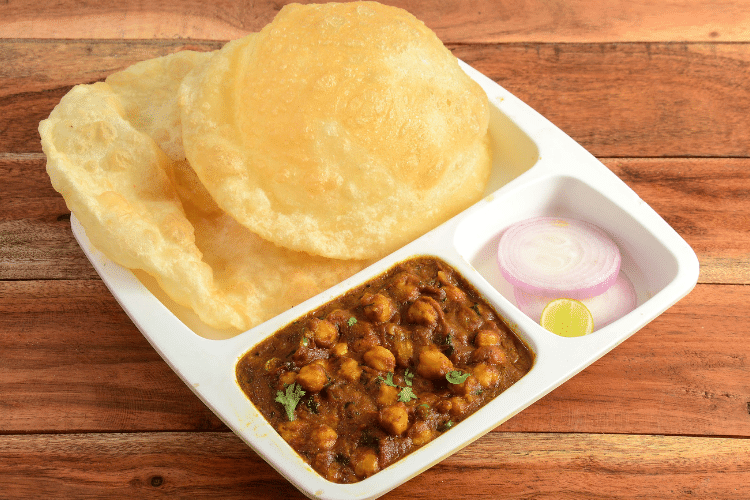
What if I told you that the taste of these streets in North India is better than that of any restaurant? That’s right—street stalls serve the palatable chole bhature, also known as chana bhature. While the fermented maida dough used to make puffed bhature or puri is deep-fried till golden brown, the chickpeas are cooked in a spicy, tomato-based sauce that doubles their flavor. This can be eaten for lunch, dinner, breakfast, or even as a midday or late-night snack. Chole bhature, a popular street meal, tantalizes your palate with its perfect harmony of sweetness and spice. They come with pickled veggies, chutneys, onions, and raita. Entice your taste buds with this scoop of chole in bhature, and let this delicious food to sate your desire for something fresh!
Alternative: Vegans can take puri, which is made of wheat, in place of bhature.
7. Naan with Tikka Masala:
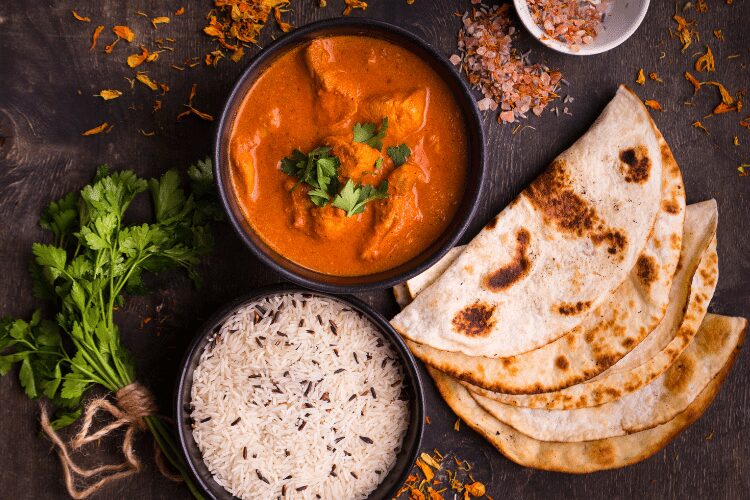
One of the staple dishes of India, naan, which means bread in Persian, is a popular leavened flatbread that is enjoyed all over the world. Although they were formerly baked on pebbles, they are nowadays cooked on an iron griddle (tawa) or in a cylindrical-shaped tandoori oven. To make the dough, flour, yeast, eggs, milk, yogurt, butter, salt, and a small amount of sugar are combined. The dough is set on the tandoor walls, facing downward, at a high temperature to form an extraordinarily large pizza-slice shape. You’ll encounter two varieties of bread: Naan-e-Tanuri, which is heavy, and Naan-e-Tunuk, which is thin bread. There are other varieties of flavored naan available in India, but the classics are butter and garlic, paneer, chilli (hot version), and plain naan. Pairing them with vibrant Indian curries, sauces, and chicken or paneer tikka masala (my personal favorite combo) brings out their finest tastes. Enjoy this food that is drizzled with butter whenever you get the chance.
Chicken Tikka Masala- the scrumptious dish, chicken tikka masala, is made up of boneless chicken morsels that are marinated in a mixture of yogurt and Indian spices, including ginger, garlic, and garam masala, before being roasted in an oven or tandoor. Indian chefs working in Britain are believed to have created this famous curry. To make the meat soft, butter or oil is applied to it repeatedly. The roasted chicken is then simmered in a base of sparkling orange, thick, and creamy sauce that has been made with coconut milk, tomato puree, cream, an array of masala spices, fenugreek leaves, and cashews. Typically, they are served as sizzlers with chutneys made of coriander or mint, and they taste great with naan and basmati rice when dipped. They are the ideal dish to try if you don’t have much experience tasting Indian food, as they have a flavorful blend of soft, juicy, spicy, creamy, and smoked notes. In every aspect, chicken tikka masala is an enticing dish that has become famous all over the world by captivating palates.
Paneer Tikka Masala- cooked using the same method as chicken tikka masala, paneer tikka masala is a classic, creamy Indian meal. To ensure that the paneer is not overcooked in the curry, it is first roasted or grilled separately and then added to the curry masala just before serving. This traditional Indian meal is perfect for both vegans and non-vegetarians, so give it a shot if you’re craving something charred, creamy, and piquant-flavored.
8. Malabar Fish Curry:
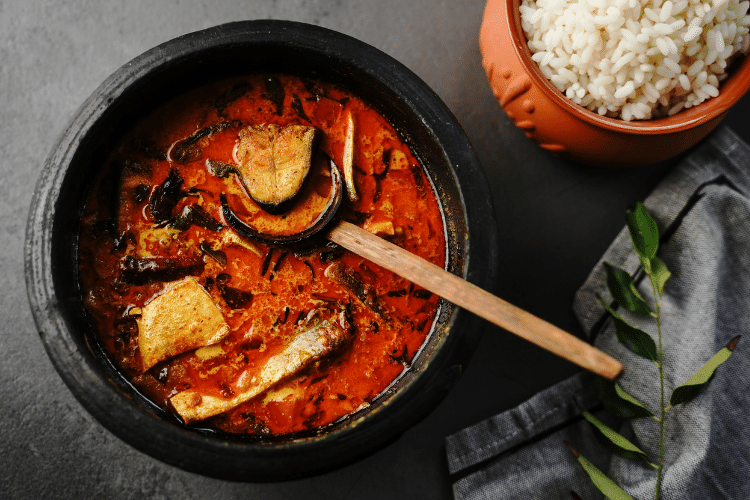
Given that Kerala is the birthplace of seafood, it would come as a shock to anyone if they didn’t encounter Kerala’s exotic foods in India. There’s nothing like this popular Malabar fish curry to make you lick your lips with delight. With an initial base of coconut-tamarind and a mixture of fiery spices, the standard curry is made with sardines, kingfish, seer, or other types of fish. While the curry leaves and onions offer the gravy a special taste, the coconut adds creaminess and thickness, and the combination of spices gives off an earthy scent. Overall, seafood enthusiasts who enjoy vibrant, fishy foods plus those who prefer an explosion of flavors will particularly enjoy this creamy, velvety, fiery Malabar fish curry. Steamed matta rice and basmati rice is the ideal companion. It should be noted that, while coconut milk might help in tampering down the spiciness of chilies, fish-based curries and meals tend to be extremely hot and tart.
9. Idli:
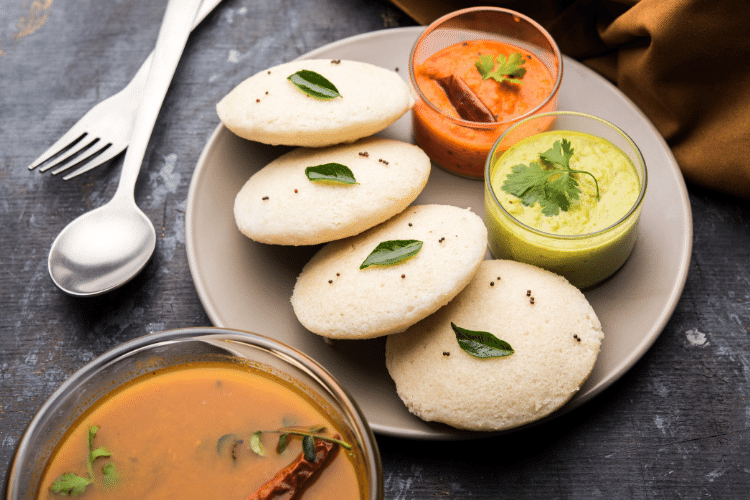
Besides being an ancient Indian food that has thrived over many generations, this well-liked idli is also quite healthful. This breakfast food from Tamil Nadu, whose origins are unknown, has become a staple in South India and is the most renowned globally. A batter of fermented black or white lentils and rice is used to make idli. The batter is left to soak for a whole night and then steamed into a delicate, fluffy little cake. Idlis go perfectly with a steamy hot cup of sambar (vegetable stew), mildly spicy coconut chutney, or fiery fish curries, as they are somewhat bland on their own. They can also be eaten with chutneys made of mint, coriander, tomato, and red chili. They are usually served hot, and another variety involves tossing the idli with veggies and seasonings.
Restaurants serve several kinds of idli, like masala idli, tatte idli, button idli, mini idli, and rava idli, each with a distinct taste and texture. They can be found from upscale five-star hotels to pushcart vendors, and as they are easily digestible, they are an optimal choice for the elderly, children, and ill people. You won’t be able to get enough of this delicious tiny Indian pancake when you dip it into authentic Sambar or classic chutney. Tip: It will taste best when paired with idli podi and oil (this is my personal favorite, and idli podi is available in stores and houses). You can enjoy them at any minute of the day.
10. Masala Chai:

Masala chai, a traditional and popular tea that can be found everywhere, from upscale five-star places to street chaiwallas, was created to satisfy the spice-loving palates of Indians who prefer lighter drinks. The most traditional way to make masala chai is to boil water, add fresh powdered tea leaves, crushed ginger, cloves, cinnamon sticks, and pepper, and steam the mixture until it changes color. Then, add sugar and milk, continue to simmer for a while, and drain the chai. The blend of hot milk and the infusion of spices and leaves give this beverage an exceptional taste. The true deal in masala chai may only be found in India, despite the fact that you can get many diluted variations of it and teabags everywhere in the world.
The anti-inflammatory and antibacterial qualities of spices like ginger, cardamom, and cloves help prevent infections, aid in the reduction of belly fat (when taken without milk), and improve digestion and metabolism when drank regularly. Nothing compares to placing your order at a chaiwala and enjoying a hot, aromatic cup of masala chai on a hectic day!
11. Chana Masala:
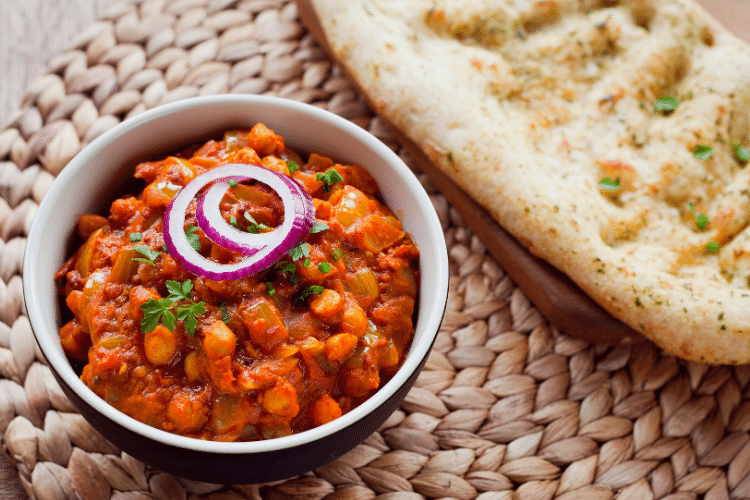
The one snack you can find anywhere from luxury dining venues to train station platforms is the best-known vegetarian curry in India, chana masala. Often referred to as chickpea or chole curry, this North Indian Punjabi dish is made with white chickpeas. The backbone of chana masala is a spiced, tangy tomato sauce in which the chickpeas are stewed to absorb the spices. The distinct fragrance of garam masala, crushed spices, onion, coriander, and amchoor (mango powder), together with a tiny bit of jaggery to boost the flavor, are all evident in this curry. This curry has a lot of protein and fiber content since it contains the legendary chickpea.
With each bite, the chana masala distinguishes itself from other curries with its heat, richness, and sour flavor enhanced by spices. If you’re a plant-based foodie or a vegetarian who is open to a new range of flavors, this aromatic curry is an excellent choice to try. The best times to eat chana masala are for breakfast and dinner, or as a sizzler for an evening snack. Puri, steamed rice, naan, parotta, chapati, and roti are served with them for a filling meal.
12. Tandoori Chicken:
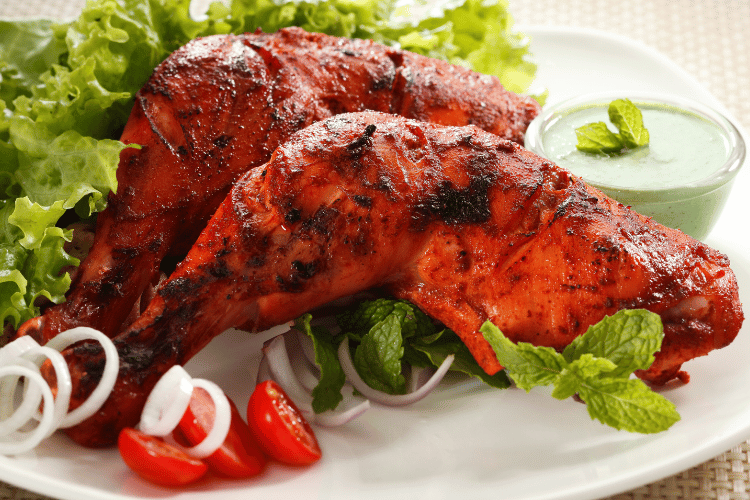
One of the well-liked saporous Indian dishes, tandoori chicken, gets its name from the clay tandoor oven that is commonly used to cook it. Following the division of Pakistan and India, Kundan Lal Gujral created this decadent dish and opened a restaurant in Delhi. The key ingredient that gives this dish its flavor is the yogurt mixture that the chicken chunks are soaked in, along with finely ground spices like nutmeg, cumin, ginger, garlic, onion, and garam masala. The blazing red color of the meal comes from the addition of cayenne pepper, plain or Kashmiri red chili powder. After marinating, the chicken is skewered and cooked over an open flame (high temperatures) that is fed by charcoal or wood.
The result is appetizing, with a crispy, crunchy exterior and a tender, juicy interior infused with a hint of smoke. Along with dipping sauces, lassi, lemons, onions, and coriander, they can be served with hot rice or naan. Crispy naan types, parottas, rotis, and basmati rice go well with tandoori chicken for a pleasant dinner. Anyone seeking a bold, flavorful meal that will challenge their palate should definitely try this tandoori chicken.
Alternative: For a vegan or gluten-free option, try tandoori gobi or tandoori aloo instead of tandoori chicken; for seafood lovers, try tandoori fish and shrimp.
13. Gobi Manchurian:
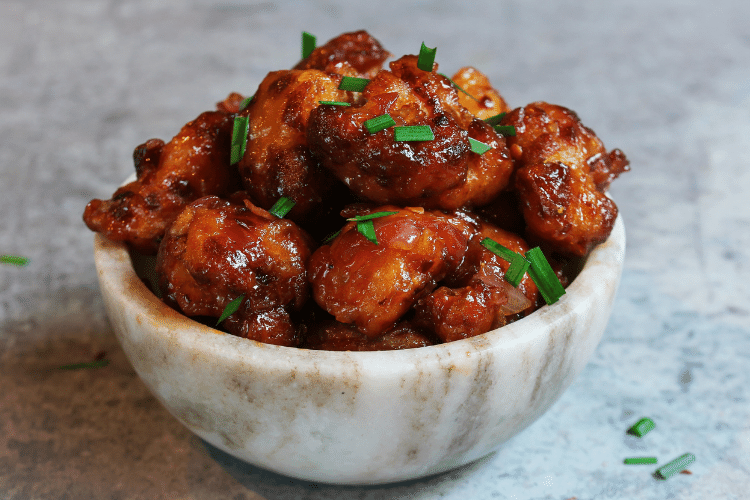
This meal, called gobi manchurian, is an Indian Chinese specialty that is highly sought-after. In order to make this sizzler, cauliflower (gobi) florets have been boiled and then dipped in a batter of maize flour, maida, salt, ginger garlic paste, soybean sauce, and chili powder, then deep-frying them till they turn golden brown. After that, the fried gobi is sautéed in a fiery, sour manchurian gravy that was made with onions, celery, capsicum, spring onions, and sauces like vinegar, soy, and tomato. Despite not being an everyday meal, gobi manchurian is a popular food that should be enjoyed to truly feel the breath of a dragon.
Because it contains large amounts of oil and salt, which are not ideal to take frequently, eating too much gobi manchurian can cause health problems. You may devour them as sizzlers or as an accompaniment to a main dish, such as steamed rice, fried rice, or noodles. Having precisely the ideal amount of sour, spicy, and sweet flavors, these bite-sized treats are a timeless snack.
Alternatives: Other options for gobi include paneer, lamb, prawns, chicken, and fish.
14. Pani Puri:

Pani puri, also referred to as golgappa, is a famous one-bite Indian food that has attracted attention from around the world. This unusual street food, comprised of a deep-fried hollow puri in a round shape with filling inside, is believed to have been born in Bihar, North India. This street food offers a whole new level of eating pleasure because you have to use your thumb to poke holes in the top layer of the small puri, fill the masala inside, and then dip them in spice-packed water (pani). While the puri is prepared with all-purpose flour kneaded into dough balls and fried until crispy, the masala is cooked using spicy mashed potatoes, onions, chickpeas, and chaat masala.
In order to experience the yummy stuffing without spilling any, the pani puri should be eaten in a single quick bite. Seven distinct flavors—from tamarind, jaljeera, and lemon to mint and garlic—are available for this cherished street food. Because of the added spices, snacking on pani puri helps with digestion; regardless, as they raise cholesterol and blood pressure, they should not be consumed frequently. They are delicious when devoured as sizzlers. Explore the bursting of flavors by popping the entire puri in your mouth!
15. Samosa:
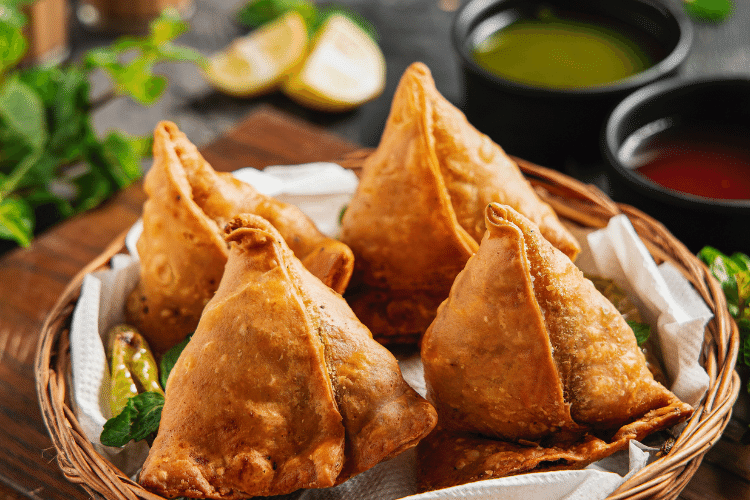
Next up on our list is the scrumptious stuffed samosa, which is originally referred to as “sambusa” in Ethiopian cuisine and made its way to India through ancient traders. A popular Indian dish and everyone’s all-time favorite street snack is the samosa, a crisp-crunch pastry. It is made by shaping dough into a triangle or conical shape, then filling it with mashed potatoes, onions, peas, lentils, and a variety of spices. The filled dough is then baked or deep-fried until golden brown. These are tempting sizzlers served with yogurt, chutneys (such as mint, tamarind, tomato, and coriander), fried chilies, and chopped onions. You may be surprised to learn that samosas, which are free of eggs and dairy, are vegan when they aren’t fried in ghee or butter.
As you travel throughout Asia, you will also see variations in shape, size, fillings, and level of spice, ranging from mild to intense. Try them with sweet chutneys to balance the varying levels of spice. This crispy, layered pastry is perfect at any time of day. It may be eaten as a lovely starter, an evening treat, a lunchtime snack, or even as a side dish. On your next culinary journey, make sure not to miss this puffy, crispy, and flavorful-filled samosa.
Alternative: For those who love meat, there’s also meat-filled samosas made with ground lamb, beef, or chicken with the above-mentioned ingredients.
16. Appam and Stew:
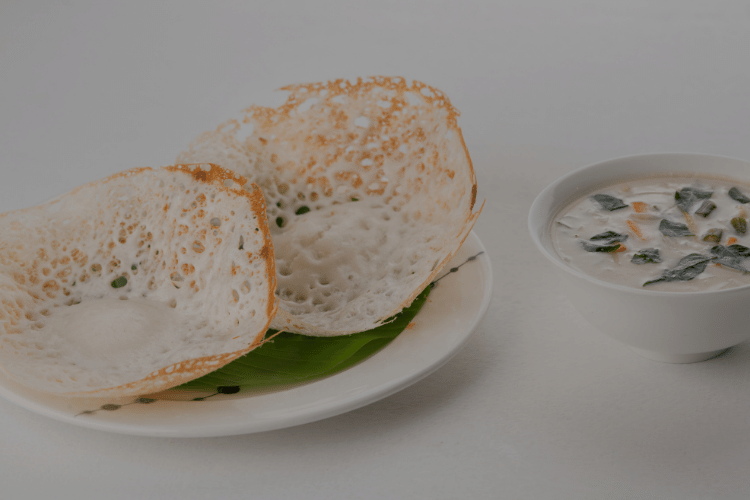
Have you ever been curious about trying Indian pancakes? If so, the right choice for you would be appam with stew, a famous South Indian pancake dish. This is a favorite breakfast in Christian households and can be found in most Keralan restaurants, where stew is inspired by European cuisine. With a little sugar, coconut milk, coconut water, and fermented rice, a batter is prepared to make it. It is steamed without being flipped, giving it a special bowl shape with a thin, crunchy edge and a soft, spongy center. Conversely, stew is made with diced veggies such as potatoes, carrots, beans, and (optional) mango chunks, coconut milk, and flavorful South Indian spices.
To make the stew non-vegetarian, chunks of lamb or chicken are added. Whatever the case, this curry, though seasoned with aromatic spices, is not as fiery as other Kerala curries and has a hint of sweetness. Appams can be eaten with spicy vegetable, chicken, or mutton stew, or with sweetened coconut milk; nevertheless, vegetable stew is the most perfect pick overall. Taste-seekers will be drawn to this delicious Malabar cuisine by the aromatic blend of ground spices and subtle sweetness.
17. Pav Bhaji:
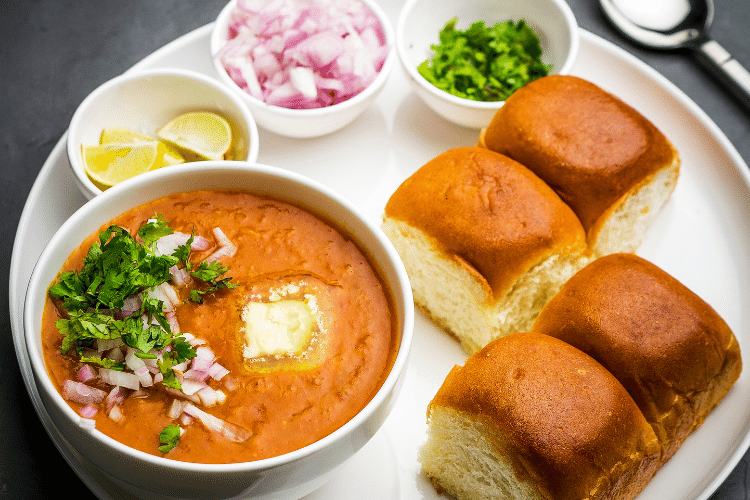
A Maharastrian-desired food that is renowned for its buttery flavor and velvety texture is pav bhaji. The majority of Indian street foods have soft bread, or buns, as an accompaniment. As well, pav bhaji is crafted with tender buns (pav) that have been toasted lightly with butter and topped with another piece of butter. Mashed-up vegetables seasoned with chaat masala and ground spices are used for preparing a fiery thick gravy (bhaji), which is served hot for dipping. Whether you like your pav bhaji spicy, garlicky, or sweet-spicy, you can customize your order. Even though it was created as a quick meal for mill workers, it quickly became popular worldwide, spotted from roadside carts to high-five hotels. Best as a small dinner or an evening snack.
Alternative: Chapati, roti, or brown bread can be used in place of the usual soft bread or buns that go with curry.
18. Ras Malai:
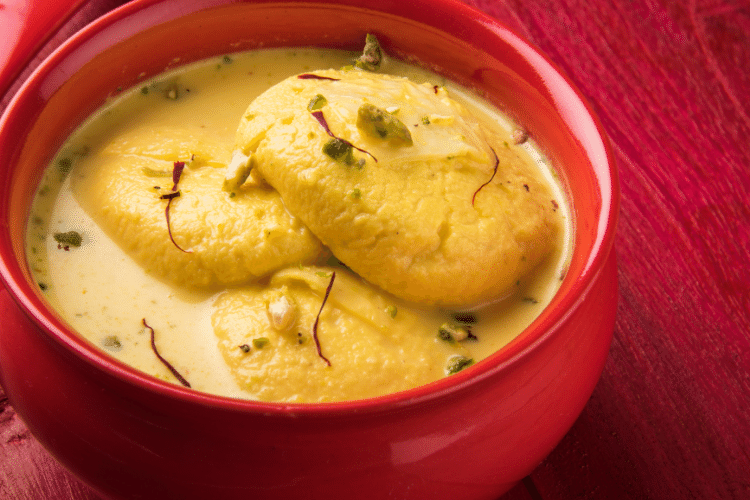
Indian cuisine is notorious for its spice, but gladly, they also offer a lot of sweet varieties. Ras malai, a beloved Indian dessert that is typically consumed during festives like diwali and holi, has its origins in West Bengal. They are made by adding a tiny bit of vinegar or lime juice to the boiling milk to separate the curdled milk solids. After that, the solid curdled milk is drained, let cool, and then kneaded into dough. The squeezed dough balls are then drenched in thick, sweet condensed milk scented with cardamom or rose water. At last, the aromatic and squishy ras malai is topped with almonds, pistachios, and saffron before being served chilled. This palatable dessert will surely make you drool for more of its sweetness! Ideal served as a post-meal dessert. Please take note that foreigners or those sampling this filling Indian dessert for the very first time will find it sweeter.
19. Chettinad Chicken Curry:
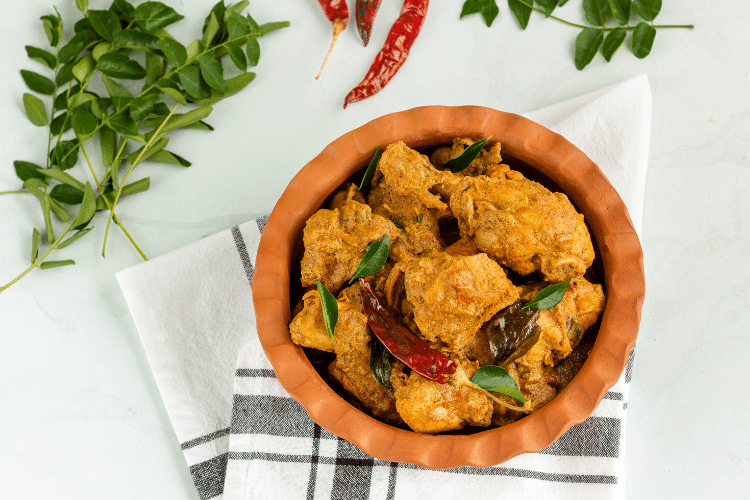
Is spicy chicken calling your name? For a flavorful twist, try this authentic chettinaad chicken. This classic food has its origin in its name, Chettinaad, a place in Tamil Nadu. Also known as chicken chettinaad, it is a hot and spicy curry of chicken that is recognized for its robust and fragrant flavors. The curry base, which is made with ground spices such as red chilies, coconut, kalpasi, cumin, coriander, fennel seeds, black pepper, garlic, ginger, onions, and gingelly oil, is combined with the marinated chicken. The black pepper and red chilies lend it a distinct spicy flavor and scent. This flavored curry has a well-balanced taste profile in addition to a special spice blend of hot gravy. Delicious combinations include rice, phulka roti, Malabar parotta, and plain parotta with chettinaad chicken. This chettinad chicken curry, developed specially for foodies and spice aficionados, will definitely perks your taste buds.
20. Matar Paneer:

The delectable matar paneer is another beloved Indian dish, particularly among “vegetarian” diners. In Hindi, the words “peas” and “Indian soft cheese,” respectively, are “Matar” and “Paneer,” which is a mildly spicy curry native to North India. It is made by slowly simmering green peas and paneer in a gravy comprising onion, tomato sauce, whole milk, yogurt, herbs, cashews, and garam masala (blended ground spices) and topped with heavy cream. Similar to butter chicken, naan, aloo paratha, ghee paratha, chapati, roti, and steaming rice pair best with matar paneer. The delicious flavors of this finger-licking curry will explode in your mouth as you dip your flatbreads into it. This is the perfect meal for kids and those who don’t like spicy food.
21. Vada Pav:
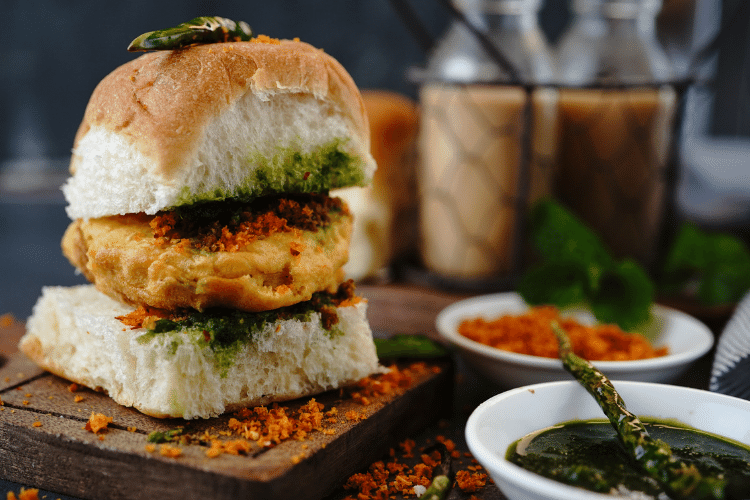
Vada pav, a popular street snack in Mumbai (Bombay), is a luscious Indian veg burger that has become insanely famous around the world. Due to its burger-like appearance and native Maharastra state origin, this legendary food also goes by the name “Bombay burger” and can be found in eateries and street stalls. In order to satiate the famished laborers, street seller Ashok Vaidya first offered vada pav at a railway station in the 1960s. A spicy mashed potato patty called “Vada” is dipped in chickpea batter, deep-fried, and then placed into a tiny, soft bun called “Pav.” They arrive with a seared green chili and a bunch of chutneys, including coriander, mint, chili, garlic, and tamarind.
Interestingly, August 23rd is Global Vada Pav Day every year. Your taste buds will be exposed to a harmonious blend of sour, sweet, and spicy flavors by the crispy layer and filling inside. Relish these vegan deep-fried fritters as brunch or teatime bites. Vada pav, the finest snack option to eat if you’re starving while strolling through Mumbai’s streets, offers diverse flavors and textures.
22. Puttu Kadala Curry:
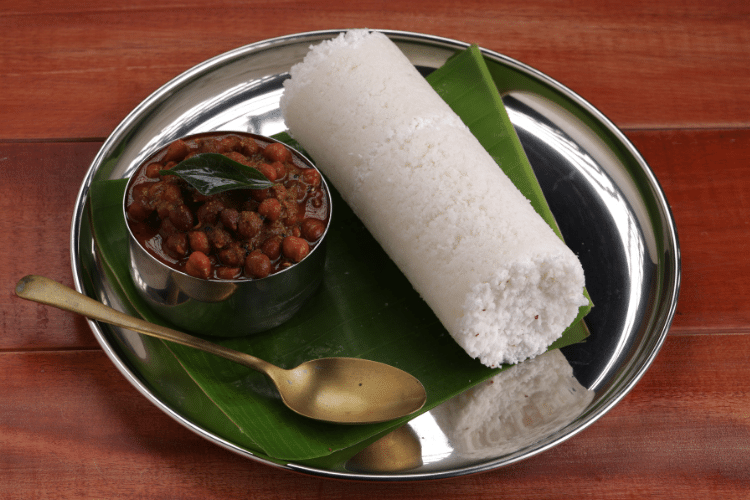
Puttu and kadala curry is a food that can be found anywhere in the state, from food trucks to five-star hotels, just like water. This classic meal is a staple of every Keralan home’s breakfast menu. Puttu is a type of rice cake made with milled rice layered with coconut shavings and (optional) banana slices and then steam-cooked in a cylindrical puttu-making vessel. Puttu is typically paired with kadala curry, a rich, enticingly spicy coconut gravy made with black chickpeas (kala chana). Lastly, ghee, sugar, ripe banana, and coconut shavings are offered for those who wish to cover their palates with sweetness; chickpea curry is served for those who prefer a spicier dish. Because it helps with weight loss and fast digestion, it’s best for breakfast but is also appreciated for lunch or dinner. The perfect combo to try at least once in your life is this popular puttu and kadala curry.
Alternative: Various substitutes are available for puttu, including millet, red rice, quinoa, and cracked wheat.
23. Bisi Bele Bhath:
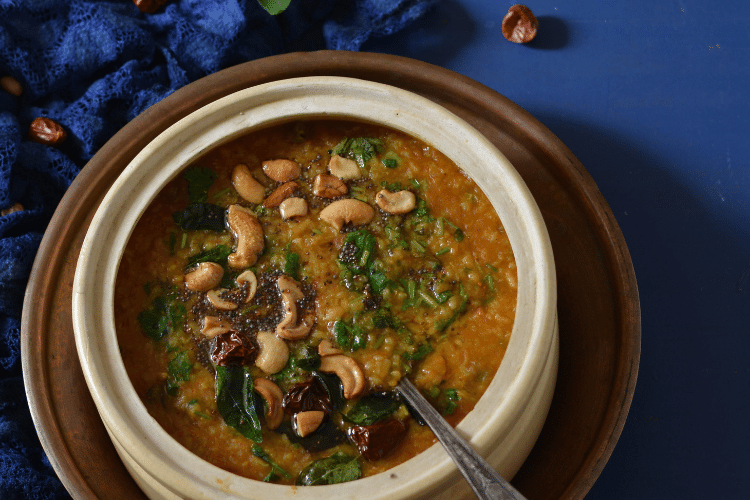
Another celebrated food from the Indian state of Karnataka is bisi bele bhath, which translates to “Hot Lentil Rice.” Indeed, this dish features rice, daal, and veggies mixed into a porridge-like consistency, tempered with nuts and Indian spice masalas. Invented during the reign of the Mysore Maharaja, bisi bele huliyanna became a massive hit throughout the state. To achieve the genuine aroma and taste, ingredients such as toor daal or urad daal, coconut, peanuts, tamarind, jaggery, spices, veggies, and a unique spice powder are added. Next, sautéed curry leaves, cashews, dry chilies, or just ghee are topped on the bisi bele bhath.
They are finally enjoyed with potato chips, papad, or the Indian snack kara boondi, which is deep-fried spicy chickpea flour. This is a delectable and nutritious two-in-one dish that helps with cold and cough relief, improves metabolism, and is ideal for the winter months. Everyone will have a taste of their favorite Indian cuisine, whether it’s hot curries or a delightful lentil dish, but this spicy, sugary, and tart bisi bele bhath is a little bit better than the rest.
Alternative: Substitute rice with millets or brown rice and avoid ghee if you prefer not to.
24. Kachori:
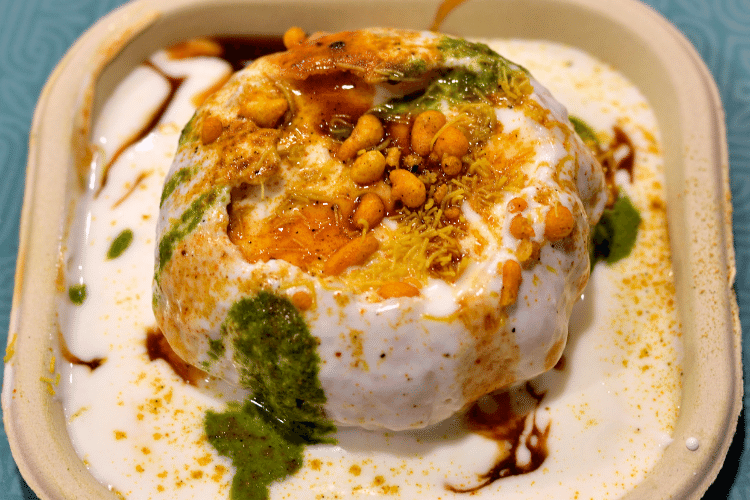
If you wish to experience savory pastry versions like empanadas, this popular kachori, known by many other names, should be on your dream list. Along with bearing several names, kachori is a snack that can be spice, sour, or sweet depending on the masalas used. Its dense filling is wrapped in a crunchy, smacky outer layer. It is made by kneading maida or wheat flour into a dough, stuffing it with lentils, veggies, and ground spices, then deep-frying it.
As always, the ingredients will differ based on what people prefer locally. A flawlessly puffed and brittle Khasta kachori is filled with spiced moong dal masala. Raj kachori comprises a big puffy kachori packed with fiery potatoes and enticing toppings like yogurt, mint, kara boondhi, and sev. The caramelized onions that fill Pyaz ki kachori give it a sweet, tangy flavor. Dal kachori is loaded with spicy ground urad and chana dal masala. Aloo kachori has mashed potatoes with ground spices. The filling of a matar kachori is hot green pea puree. Kachori chaat is a crumbled variety. On the contrary, Mawa kachori is a sweet version made with sugar, khoya (mawa), and a mixture of ground nuts that have been dipped in sweet syrup.
Though eating kachoris frequently can cause health issues due to their refined carbs, fats, and sodium content, occasionally enjoying them is a good idea. It tastes best as a morning or late-night snack. This well-known kachori dish, which is served with yogurt, sev, kara boondhi, mint and coriander leaves, and a wide range of chutneys like meetha, mint, and tomato, is noteworthy for its diverse flavors and textures.
Alternative: Baked kachori, which lowers the oil level while maintaining the flavor and texture, is a healthier take on deep-fried kachori.
25. Roghan Josh:
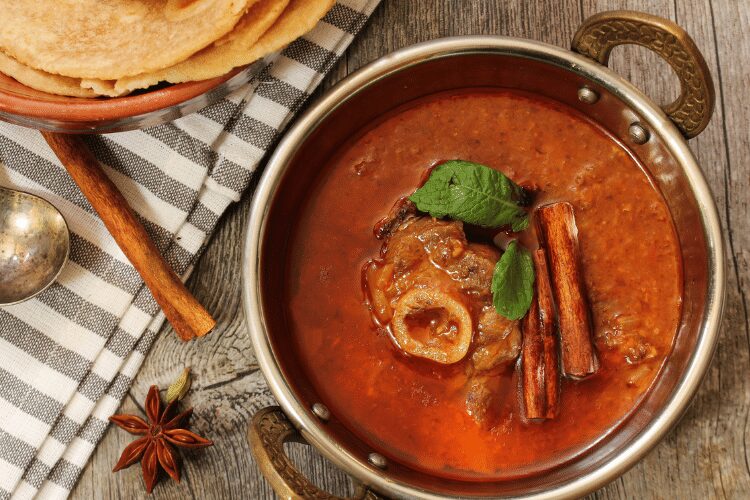
The authentic Indian rogan josh is a must-try if you’re craving something vibrant and flavorful. Rogan josh has become extremely popular in the Kashmiri region of Northern India, despite being a Persian dish that originated with the Mughals. Tender lamb or young goat meat chunks are simmered in a bright red curry sauce with aromatic spices, dried Kashmiri chillies, onions, garlic, ginger, and yogurt or tomato sauce for thickness. The term “Rogan” means “ghee” in Persian and “red color” in Hindi, while the word “Josh” means “hot” in Persian. Traditionally, this delicate meat with a spice-infused curry is slow-cooked to achieve its unique color.
This well-known Indian meal is a classic not only in India but also in eateries in the United Kingdom. Since these chilies are de-seeded before cooking and are far less fiery than cayenne chilies, the spice level will be mild. For lunch or dinner, fluffy hot rice, parotta, or naan give the perfect complement to rogan josh. So, for Western palates who prefer subtle heat and enticing flavor, this hearty meal is the yum-yum option.
Alternatives: Whether you like plant- or meat-based cuisine, Modern Rogan Josh will undoubtedly satisfy your palate, as it comes in chicken and vegetarian versions.
26. Kadai Chicken:
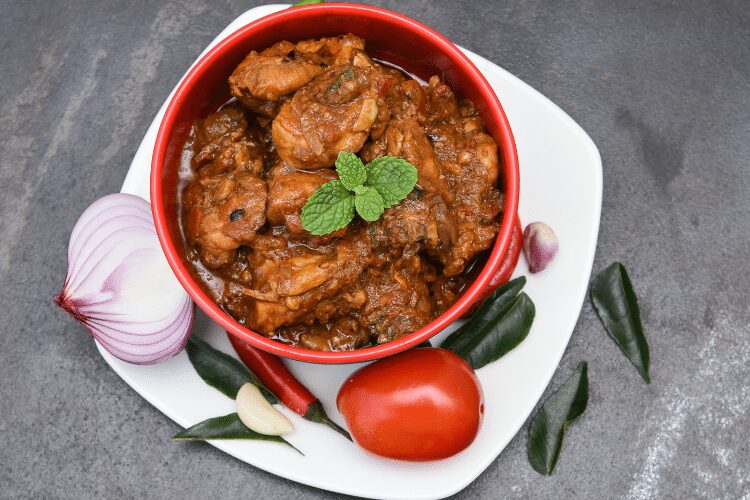
Try this daring North Indian meal without holding back! Kadai chicken, a melange of spice, sweet, and sour flavors, is from Punjab. Served in restaurants, hotels, and dhabas, this fiery, savory meal got its name from the ancient iron kadai, an Indian cooking pot that resembles a wok. The star of this curry is the soft chicken chunks, which are marinated in a yogurt, cumin, red chili, and coriander mixture before being perfectly roasted. Dry-roasted chicken is cooked with a puree of tomato, whole and ground spices, onion, and capsicum. It is then presented with fresh cream or butter and coriander.
The fast-cooking method, which involves cooking the chicken over high heat in a little time period, preserves its freshness, and the addition of tomatoes and bell peppers sets it apart. It tastes great when coupled with tandoori roti, butter naan, parotta, chapati, jeera rice, or steaming basmati rice. Juicy roasted chicken, flavorful spices, and colorful veggies join together to create a visually appealing and tempting curry that is now a beloved dish among people beyond boundaries.
27. Malai Kofta:

Malai kofta, a Mughalai cuisine that is now a favorite comfort food in North India, is made with vegetarian fried meatballs (kofta) and served with a wealthy, creamy sauce (malai). Paneer dumplings, known as kofta, are made with mashed potatoes, crumbled paneer, and aromatic spices, blended into little balls that are deep-fried and placed on a creamy gravy of tomatoes and onions. Its impeccable serving technique distinguishes it from others; the dumplings are mostly placed on the milder sauce right before serving to maintain their crispy, flaky quality without being squishy. The dumplings come in various shapes and sizes, along with two varieties: a creamy sauce with a light color or an extra-hot orange curry.
This well-liked malai kofta will entice you with its velvety, crunchy, and non-spice taste and bring all the epicurean Indian flavors to your table—even if you prefer spicy meat. Ideally paired with garlic naan, butter naan, roti, cumin rice, ghee rice, jeera rice, or basmati rice. A meal you will definitely be licking your fingers is malai kofta, garnished with cream and coriander leaves!
Alternative: If you’re still craving meat, try the lamb or chicken meatball kofta; they’ll taste just as good.
28. Karimeen Pollichathu:
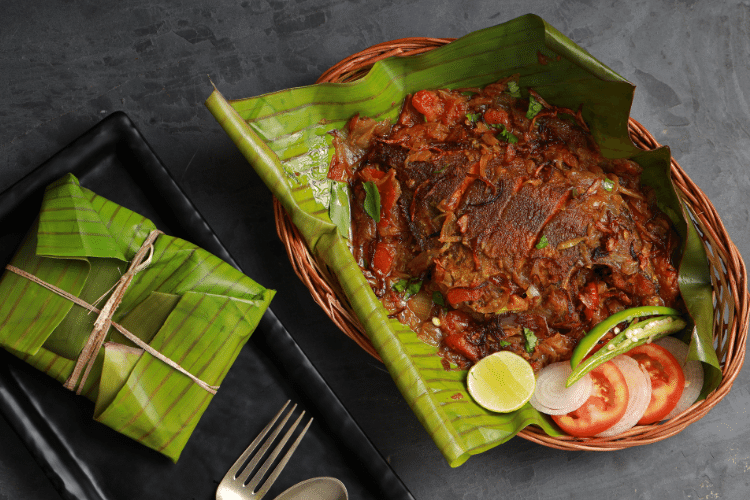
A succulent dish that hails from Kerala, karimeen pollichathu is a flavorful combo of spices and fresh fish. Made with speckled fish found in the backwaters called karimeen (pearl spot fish), it is wrapped and served hot. This meal has become extremely well-known both inside and outside of the state, despite being a traditional Christian delicacy from Syria. After marinating the fish in a mixture of chilies, lemon juice, and chosen spices, it is wrapped in plantain leaves that are packed with sauteed onions, tomatoes, curry leaves, and other ingredients. And then it’s perfectly grilled or roasted. Popular karimeen pollichathu, devoured hot with the leaves wrapped around, has a particular flavor from the aroma of the leaves infused with the fish. At breakfast or dinner, it tastes best when served with hot rice or chapati.
Alternative: To prevent using too much oil, steam the kairmeen polichathu rather than frying them.
29. Dal Makhani:
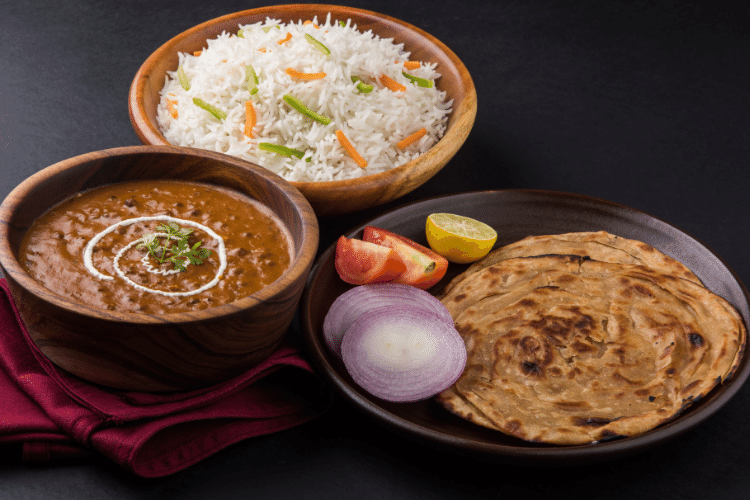
Even though it can be found in any Indian eatery, nothing compares to the luscious, creamy, butter-laden lentil curry, dal makhani, that comes straight from the originated place, Punjab in North India. The word “Dal” refers to “lentils”, and “Makhani” to “butter”. An attractive and upscale dal makhani is made with black lentils (urad), red kidney beans (rajma), or black beans, together with flavorful seasonings, cream, and butter in a tomato-based sauce. Dal makhani is unmatched in taste thanks to its slow-cooking technique, which involves stirring the ingredients at a low temperature over a charcoal fire for hours. This makes it possible for the flavors to merge well and create a deliciously creamy, buttery flavor.
This drizzling dish is served hot as a partner to a main vegetarian food or as a side dish to flatbreads like roti, naan, or parotta. Although this cuisine is saved for formal occasions like weddings and gatherings, consuming too much of it leads to excessive calorie intake. If you enjoy Indian cuisine, you will undoubtedly love every delicious bite of this butter-drizzling Dal makhani. To experience this delightful culinary journey, all you need to do is travel to Punjab.
30. Lassi:
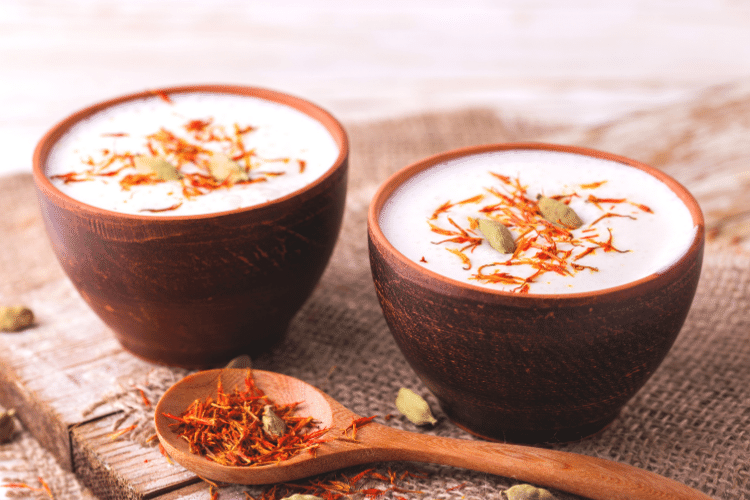
Have you ever had the refreshing lassi drink that is usually served in kulhars (clay sipper cups)? If your reply is “no,” then you should sample this well-liked, thick, creamy, and frothy North Indian drink. A blend of yogurt or curd, water, salt or sugar, spices, herbs, and fruits like strawberries, bananas, and mangos is used to make this lassi beverage. That being said, lassi is not only yummy but also healthy for your gut and digestion, helps you control your weight because it contains little fat, and keeps you cool on hot, sunny days. While the appearance of a lassi drink resembles a cross between a yogurt-based drink and a milkshake, it tastes too much like an ayran or doogh.
It is best enjoyed on its own at sunset, but you will get the full flavor effect when you drink it after a hefty meal high in spices. There are a lot of varieties of lassi that you can find, including kesar, sweet, salty, masala, banana, strawberry, and mint. However, mango lassi is undoubtedly the most delicious. Although the flavor of milk and salt together may sound strange to you, this tangy-sweet mix is very popular in India and needs to be on your list of must-tries.
Alternative: For those who don’t consume dairy, plant-based cashew or soy yogurt can be used instead!
Warning: Be aware of the ingredients in the meals you decide to eat. Take appropriate precautions and tell the chef not to add specific ingredients if you have allergies to things like nuts, yogurt, black raisins, gold raisins (which include chemicals to keep color), or any other. While korma is often less spicy, the South Indian version of korma has plenty of spiciness.
The majority of Indian dishes are made up of vegetables and spices, which are full of health benefits. When paired with the right accompaniments, the food’s flavor is boosted. Consuming foods with your hands is viewed as clean in India and is a perfect way to fully appreciate your food. However, if you’re not familiar with it, you can make use of the forks and spoons that the restaurants provide. Your taste senses will be forever captivated by the curries served, as these Indian dishes are crafted using centuries-old blends of spices and cooking methods.
From milder meats to fiery seafood with an array of flavors, every region of India, from Delhi to Kerala, adds its own personal touch to cuisine. Whether you are craving buttery curries, indulgent vegan cuisine (with most people not eating meat), crunchy snacks, or devouring desserts, India is the ideal getaway for foodies worldwide. So, get lost in this soothing journey of the Top 30 popular Indian foods. Make sure to pass on your insightful experiences with us. With great anticipation, we await!


